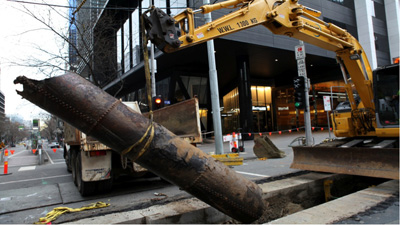City West Water hit rock bottom in 2003, with the worst water main failure rate of all major water utilities in Australia. More than a decade later, the successful implementation of proactive asset management plans has turned the situation around.
By Carla Grossetti

The 2002–03 financial year was an annus horribilus for City West Water (CWW), with the Victorian Government-owned retail water business recording the worst water main failure rate of all major water utilities in Australia.
Just over a decade later, the Melbourne utility company’s proactive approach to fixing these water main failures has resulted in a dramatic reduction in supply interruptions, placing the authority in a vastly improved position.
CWW’s Asset Performance Manager, Max Anderson, says he’s proud to say the company’s aggressive water main management practices have improved both its long-term performance and the public’s perception of the utility. He says the aggressive plan of action included the introduction of a proactive failure analysis process, increased condition assessment using electromagnetic scanning, the development of an Asset Risk Management Model, and the initiation of a reporting tool designed to undertake daily monitoring of the number of times a customer has lost supply in the past 12 months.
“It didn’t happen overnight – in fact it took two to three years – but the whole exercise of identifying mains and expediting the time it takes to renew those mains has improved dramatically,” says Anderson, a civil engineer with almost 40 years’ experience working in the water industry.
Anderson presented his paper, The Reduction of Water Main Failures at City West Water at last year’s IPWEA International Public Works Conference in Darwin, where he highlighted the value of CWW’s rigorous new operational tactics.
The paper outlines how, during the 2002–03 financial year, CWW experienced more than 3600 failures on its water mains, which translated to 105.5 breaks per 100km. Anderson also explained in the paper just how the utility got its KPIs on track, and pulled its failure rates back to a respectable 33 breaks per 100km at the end of the 2011–12 financial year.
Media coverage
Anderson says one of the most stressful aspects of the interruptions to Melbourne’s water supply was trying to rectify the situation, while caught up in a maelstrom of negative media coverage.
CWW’s Manager, Asset Reliability, Joe Vassallo agrees it wasn’t just the major failures that were the problem: a period of sustained drought had triggered an avalanche of issues, and the sheer quantity of failed assets meant crews could simply not get to them all in time.
“We were getting continual complaints on talkback radio and on the nightly news and the more that was fixed, the more that broke. What the public didn’t know was CWW was prioritising the worst failures and, on average, had a backlog of about 200 leaks to repair at any one time. At the end of the 2002–03 financial year we had about 3000 customers who had experienced more than four interruptions in the past 12 months,” says Vassallo.
“From the public’s perspective, water was still running down their street and they formed the idea that CWW was wasting water. There were news crews filming footage of houses being flooded in affluent areas such Carlton North, and that painted the water authority in a very bad light. But the full story was that it was simply not possible to get to all the minor leaks on time, and so some of those minor leaks turned into full-blown bursts,” says Vassallo.
CWW manages more than 4500km of active water mains, some of which include cast iron piping laid in the 1850s. Anderson says the spike in failures in 2003 was a combination of ageing infrastructure and the fact that Melbourne was experiencing a drought. The summer of 2003 was extremely dry and the water mains lie within zones of reactive clay soil, which expands and contracts with changes in soil moisture.
Anderson also concedes that, in order to move forward, the company had to be aware of its own failings and overhaul its approach in order to streamline its reporting processes. CWW’s assistant Water Operations Manager during the 2003 crisis, Martin Gamble says the utility would not have been able to get the failures under control unless the Board had committed to a costly water main renewal program and condition assessment program.
New beginnings
He says the appointment of a new Managing Director in 2003 shifted the focus to risk management and customer service.
“There was certainly a change in management’s approach following that high period of failure, and the new management certainly helped transform the culture of the company by introducing new people and processes for identifying and commissioning maintenance and renewal work on the assets,” says Gamble.
Anderson agrees the main reason CWW was so successful in dealing with the crisis was because everyone – from company managers to contractors – was committed to reducing the number of failures. “The company has now replaced 10 per cent of our total assets since those major failures,” says Anderson.
Anderson says CWW has renewed about 400km of pipeline in the past decade and the success of its water main renewal program is evident by the significant reduction in failures and customer complaints. He says CWW is now happily associated with dependable water distribution after changing the way it manages its water assets and reducing the number of customers who have lost water supply more than five times a year from 410 to zero.
“We don’t expect the public to say, ‘terrific job City West Water’ … we just want to get on with the job of managing the water system diligently,” says Anderson.
This article originally appeared in the March-April 2014 issue of Public Works Professional